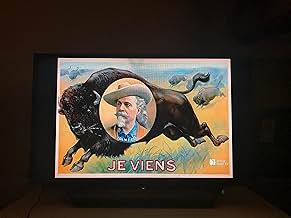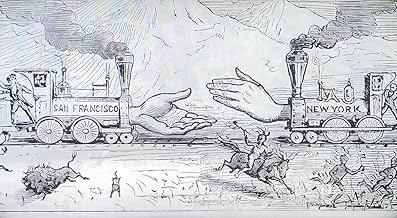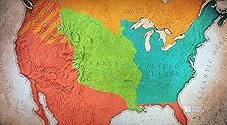Eine Reise durch mehr als 10.000 Jahre nordamerikanischer Geschichte und durch einige der berühmtesten Landschaften des Kontinents, die die Entwicklung des Säugetiers nachzeichnet.Eine Reise durch mehr als 10.000 Jahre nordamerikanischer Geschichte und durch einige der berühmtesten Landschaften des Kontinents, die die Entwicklung des Säugetiers nachzeichnet.Eine Reise durch mehr als 10.000 Jahre nordamerikanischer Geschichte und durch einige der berühmtesten Landschaften des Kontinents, die die Entwicklung des Säugetiers nachzeichnet.
- Stoffentwicklung
- Hauptbesetzung
- Auszeichnungen
- 1 wins total
Folgen durchsuchen
Empfohlene Bewertungen
Heartbreaking documentary about the exploitation and near extinction of the bison, along with the destruction of Native American cultures which depended on the animals for food, clothing, bone tools, tepee hides. Historians on the program include Native Americans and as usual with Ken Burns, the narration includes voices reading historical records.
From what I read, the second episode is more optimistic and describes the attempt to bring the buffalo back to the prairie. Maybe I will watch that one, but I had to bail on the first episode about halfway through. It was just too, too cruel to watch.
From what I read, the second episode is more optimistic and describes the attempt to bring the buffalo back to the prairie. Maybe I will watch that one, but I had to bail on the first episode about halfway through. It was just too, too cruel to watch.
I just finished watching The American Buffalo and once again Ken Burns hits it out of the park! I thought I knew the plight of the Bison, and how it also impacted Native Americans, but I learned much more about the history of the past 200 years. This is a very touching and thought provoking documentary and reminded me of the photo of a huge mountain of bison skulls I first saw as a child. I'd never even heard of the amazing meter shower of the 1880s or of the horrid Gore who killed thousands of animals just for fun. I'm looking forward to part 2 tomorrow night. At least enough calves were saved that the species did not go extinct. Thank God for Yellowstone Park.
Very simply, this film is an important story. I have to think that this is Ken, going out of his way, to subtly make a point. He could have told this story years ago, but choose "now" to do so. It is a tale of stunning ignorance and stupidity, and ought to be a must-see for everyone. Specifically, it shows how humans can simply choose to be blind to an unconscionable nightmare fiasco that they are creating, at a rapidly increasing speed, simply for the sake of money. It VERY MUCH mirrors what the larger human populace is repeating right now, except this time, WE are the buffalo.
Ken's film exhibits the fact that you can turn _some_ disastrous situations around, even though, historically speaking, we seem to have not been inclined to do so (just ask the Passenger pigeon, Tasmanian tiger, and even the mastodon, how it worked out for them).
Again, a great story. They should be showing it to kids in grade school, as that might result in some important conversations around the dinner table at home.
Ken's film exhibits the fact that you can turn _some_ disastrous situations around, even though, historically speaking, we seem to have not been inclined to do so (just ask the Passenger pigeon, Tasmanian tiger, and even the mastodon, how it worked out for them).
Again, a great story. They should be showing it to kids in grade school, as that might result in some important conversations around the dinner table at home.
10jmlj99
Hard to watch? Yes. It is heartbreaking. I started watching the show with my husband, it was very depressing, but the story and the history needed to be told and shared. We all need to know and remember how people wiped out the Native Americans and the lands and the buffaloes that sustained them. It's so hard to believe that people could not respect the land and lives of others in the past. That was the way in the past. Take what you want and who cares about the feelings and the lifestyle of the natives. I'm glad I'm in my 60's and it saddens me to see that we the American people still don't recognize how badly we screwed the native population.
Admittedly, "The American Buffalo" can be tough viewing, especially part one. But as I mentioned in my review header, it's also essential viewing. We should not and cannot live in ignorance of the past.
As one might guess, this film is about the American Bison. A better title might have been "A Cautionary Tale" or "American Holocaust," as those capture more of the essence of the material. What we are given here is a history of the bison, but because Americans hadn't really encountered it much before 1800, it's really a history of its last 220 or so years. And what an ugly history it is.
At the dawn of the 19th century the bison numbered in the millions, by some estimates 10 million or more, and by the 1880s there were perhaps fewer than 1000 left. Part one goes into great detail explaining how greed, callousness, indifference, and just plain evil made this possible.
It's very difficult not to be angered by the revelations made here of the crimes committed at the time. One despicable individual, a certain Lord George Gore, killed thousands of animals, including bison, on a 3-year hunting expedition to the West, apparently getting a thrill out of the excessive blood he shed. Many more engaged in the carnage because, as is so often the case, there was money to be made. The majority of the bison were slaughtered purely for economic reasons, as their hides, tongues and other body parts could be converted into cash. Hunters would kill them by the hundreds, day after day, and leave their carcasses to rot all over the Great Plains. I can't think of a better word to describe this madness than "sickening." And as an American, it's utterly embarrassing.
Part two details the slow reclamation and salvation of the bison, such as there is. Through the efforts of various people (some more honorable than others), the film informs that as of today (2023), the species has rebounded to number roughly 350,000. A far cry from 10 million but enough to guarantee its future it seems.
Burns has made the film in his now-recognizable style. Photographs from the time period are intertwined with musical excerpts, diary entries and interviews with historians and witnesses or their descendants, including a healthy dose of recollections from Native Americans. At one point some journal entries from the Lewis & Clark expedition are read by a voice actor, and here Burns re-uses some music from his earlier Lewis & Clark documentary, a nice easter egg for those familiar with that excellent program.
A few times Burns goes on a seemingly irrelevant or non-essential tangent, like when he gives something of a biography of the Comanche chief Quanah Parker. Mildly interesting, but the film could have been made without it. These tangents are only a minor gripe, though. Overall there is a lot here to digest, and to ponder. I can only hope the journey of the American Bison, along with the near-extinction of the American Eagle in the 20th century, will serve as warnings and cautionary tales we absolutely must heed going forward.
9/10. Burns fills in another gap of the American Experience, and this time, does it painfully well.
As one might guess, this film is about the American Bison. A better title might have been "A Cautionary Tale" or "American Holocaust," as those capture more of the essence of the material. What we are given here is a history of the bison, but because Americans hadn't really encountered it much before 1800, it's really a history of its last 220 or so years. And what an ugly history it is.
At the dawn of the 19th century the bison numbered in the millions, by some estimates 10 million or more, and by the 1880s there were perhaps fewer than 1000 left. Part one goes into great detail explaining how greed, callousness, indifference, and just plain evil made this possible.
It's very difficult not to be angered by the revelations made here of the crimes committed at the time. One despicable individual, a certain Lord George Gore, killed thousands of animals, including bison, on a 3-year hunting expedition to the West, apparently getting a thrill out of the excessive blood he shed. Many more engaged in the carnage because, as is so often the case, there was money to be made. The majority of the bison were slaughtered purely for economic reasons, as their hides, tongues and other body parts could be converted into cash. Hunters would kill them by the hundreds, day after day, and leave their carcasses to rot all over the Great Plains. I can't think of a better word to describe this madness than "sickening." And as an American, it's utterly embarrassing.
Part two details the slow reclamation and salvation of the bison, such as there is. Through the efforts of various people (some more honorable than others), the film informs that as of today (2023), the species has rebounded to number roughly 350,000. A far cry from 10 million but enough to guarantee its future it seems.
Burns has made the film in his now-recognizable style. Photographs from the time period are intertwined with musical excerpts, diary entries and interviews with historians and witnesses or their descendants, including a healthy dose of recollections from Native Americans. At one point some journal entries from the Lewis & Clark expedition are read by a voice actor, and here Burns re-uses some music from his earlier Lewis & Clark documentary, a nice easter egg for those familiar with that excellent program.
A few times Burns goes on a seemingly irrelevant or non-essential tangent, like when he gives something of a biography of the Comanche chief Quanah Parker. Mildly interesting, but the film could have been made without it. These tangents are only a minor gripe, though. Overall there is a lot here to digest, and to ponder. I can only hope the journey of the American Bison, along with the near-extinction of the American Eagle in the 20th century, will serve as warnings and cautionary tales we absolutely must heed going forward.
9/10. Burns fills in another gap of the American Experience, and this time, does it painfully well.
Wusstest du schon
- WissenswertesA hour long conversation preview with Ken Burns and indigenous leaders is hosted by Judy Woodruff on PBS 23 September.
- VerbindungenFeatured in Ken Burns: One Nation, Many Stories (2024)
Top-Auswahl
Melde dich zum Bewerten an und greife auf die Watchlist für personalisierte Empfehlungen zu.
- How many seasons does The American Buffalo have?Powered by Alexa
Details
- Erscheinungsdatum
- Herkunftsland
- Offizieller Standort
- Sprache
- Auch bekannt als
- The American Buffalo
- Produktionsfirmen
- Weitere beteiligte Unternehmen bei IMDbPro anzeigen
- Laufzeit3 Stunden 54 Minuten
- Farbe
Zu dieser Seite beitragen
Bearbeitung vorschlagen oder fehlenden Inhalt hinzufügen

Oberste Lücke
By what name was Der Amerikanische Bison (2023) officially released in India in English?
Antwort



























